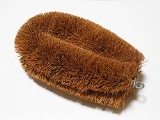
Tawashi
Encyclopedia

Kamenoko Tawashi
The is a kind of tawashi made of fiber of a hemp palm. Because the Kamenoko Tawashi is hard, durable and waterproof, it is suitable for washing kitchen equipment, bathtubs, shoes and so on. It should not be used for delicate items.The Kamenoko Tawashi is a registered trademark of in Japan.
Other tawashis


Sponge (tool)
A sponge is a tool, implement, utensil or cleaning aid consisting of porous material. Sponges are used for cleaning impervious surfaces. They are especially good absorbers of water and water-based solutions....
used for rubbing and washing are also called tawashi in Japan.
metallic tawashi
- A is a tawashi made of any metalMetalA metal , is an element, compound, or alloy that is a good conductor of both electricity and heat. Metals are usually malleable and shiny, that is they reflect most of incident light...
s (steelSteelSteel is an alloy that consists mostly of iron and has a carbon content between 0.2% and 2.1% by weight, depending on the grade. Carbon is the most common alloying material for iron, but various other alloying elements are used, such as manganese, chromium, vanadium, and tungsten...
, stainless steelStainless steelIn metallurgy, stainless steel, also known as inox steel or inox from French "inoxydable", is defined as a steel alloy with a minimum of 10.5 or 11% chromium content by mass....
, brassBrassBrass is an alloy of copper and zinc; the proportions of zinc and copper can be varied to create a range of brasses with varying properties.In comparison, bronze is principally an alloy of copper and tin...
and so on). Sometimes it is used for removing scorching and rust.
acrylic tawashi
- An is a tawashi made of acrylicAcrylic fiberAcrylic fibers are synthetic fibers made from a polymer with an average molecular weight of ~100,000, about 1900 monomer units. To be called acrylic in the U.S, the polymer must contain at least 85% acrylonitrile monomer. Typical comonomers are vinyl acetate or methyl acrylate...
, typically knitted or crochetCrochetCrochet is a process of creating fabric from yarn, thread, or other material strands using a crochet hook. The word is derived from the French word "crochet", meaning hook. Hooks can be made of materials such as metals, woods or plastic and are commercially manufactured as well as produced by...
ed.
sponge tawashi
- A polyurethanePolyurethaneA polyurethane is any polymer composed of a chain of organic units joined by carbamate links. Polyurethane polymers are formed through step-growth polymerization, by reacting a monomer with another monomer in the presence of a catalyst.Polyurethanes are...
sponge is sometimes called .
nylon tawashi
- A nylonNylonNylon is a generic designation for a family of synthetic polymers known generically as polyamides, first produced on February 28, 1935, by Wallace Carothers at DuPont's research facility at the DuPont Experimental Station...
sponge is sometimes called . it is suitable for washing tough stains, but it should not be used on delicate items.
luffa tawashi
- A luffaLuffaThe luffa, loofah, or lufah are tropical and subtropical vines comprising the genus Luffa, the only genus of the subtribe Luffinae of the plant family Cucurbitaceae...
sponge is called . It is used as a body scrub.
Eco tawashi
- Crocheted from 100% cotton yarnYarnYarn is a long continuous length of interlocked fibres, suitable for use in the production of textiles, sewing, crocheting, knitting, weaving, embroidery and ropemaking. Thread is a type of yarn intended for sewing by hand or machine. Modern manufactured sewing threads may be finished with wax or...
as acrylic yarns will melt. Scratch-free, and used for dishes and small cleaning jobs. The prefix eco- indicates that it creates less pollution because it can be used without soap or other detergentDetergentA detergent is a surfactant or a mixture of surfactants with "cleaning properties in dilute solutions." In common usage, "detergent" refers to alkylbenzenesulfonates, a family of compounds that are similar to soap but are less affected by hard water...
s. :
External links
- the history of Kamenoko Tawashi (Japanese) - Kamenoko tawashi nishio shoten co.,ltd.

